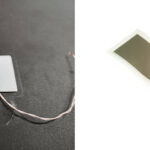A new study from Carnegie Mellon University has shown how 3D printed materials have the potential to serve as touch sensitive systems with the use of electrodes. The study used Electric Field Tomography to create a human-machine interface. Researchers 3D printed their objects using a low-cost carbon black ABS. The ABS serves as an interactive, touch-sensing item once it is coated in a conductive material layer.
Electrick Process
Firstly, conductive coating is applied to the material. This coating then serves as an electrical conductor for whatever surface you desire. It is also possible to paint over the coating for aesthetic purposes. Additional paint does not affect the conductivity of the original conductive coating.
Next, add electrodes to the desired interactive area. The electrodes inject a small current into the conductive layer. These currents serve as signals that the user can alter through contact which shunts the current, thus sending commands to a computer. The researchers created a tomographic field to further enable accurate touch sensing fields.
The method enables touch sensitivity and continuous touch tracking. This means that it can perform all of the functions of a touchscreen. It is, as of now, unknown whether it enables pressure sensitivity. The researchers then attached various command prompts to the electrodes and assigned tasks to them.
The video below shows the process in depth:
Electrick Applications
The process has many implications for the field of electronics. Firstly, it alters the way in which we can assign touch technology. Using this conductive technology, most 3D printed objects can serve as touch sensitive items. This allows users to print their own touch pads and keyboards which minimal effort.
Another reason this is a major breakthrough, is that it alters the way we think about touch technology. Touch technology can now be a peripheral node outside of the main device using a few connections. Due to the nature of this technology, users can apply new touch tech or repair their old ones on the spot.
It also has implications for the software side of the equation. As shown in the video above, with the right software or application, people can turn any surface into a guitar effects processor rig or a drum pad. In many ways it extends smartphone touch-screen capabilities to the wider region of physical objects. In essence, it can transform anything into a keyboard or a touch-pad.
The research paper is titled “Electrick: Low-Cost Touch Sensing Using Electric Field Tomography”. If you’re interested in reading the whole study it is available here on co-author Chris Harrison’s website.










